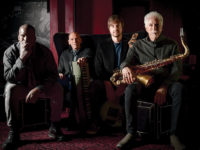Photo by Raj Naik
by S. Victor Aaron
Tomorrow, a jazz band that’s been around for 30 years will release their 21st album. Founded in the aftermath of Robben Ford’s The Inside Story (1979), Ford’s backing band has been making records since their self-titled album from 1981. Through several line-up changes, keyboardist Russell Ferrante and electric bassist Jimmy Haslip have been the mainstays. Their longevity has a lot to do not just with the virtuosity of the players, but guiding that virtuosity into jazz fusion music that’s multi-faceted, intelligent, accessible and more often than not rooted in actual jazz.
At their best moments, the Yellowjackets are the most logical heir to Weather Report (at least latter-day Weather Report), for their ability to combine modern instruments and sounds to acoustic ones and still swing like hell, keeping the spirit of striaght jazz intact. At their not-so-best moments, they can steer awfully close to nondescript smooth jazz. Since multi-reedist Bob Mintzer joined the band twenty years ago, those brushes with smooth jazz have come up far fewer times, and calling them a “smooth jazz band” is a real mischaracterization. There’s just too much complexity, too much too much swing to lump ’em in with that bunch.
Timeline does feel like the work of a band that’s been around a long time: accomplished playing that doesn’t go to extremes to flaunt the chops, an assimilation of styles into a signature sound, and focused, mature group performance. This also marks the return of William Kennedy to the drum stool. Kennedy, who was already the Jackets’ longest tenured drummer having been with the group from the mid 80s to around the turn of the century, brings a more explosiveness to the drums than his successor/predecessor Marcus Baylor, and in typical YC fashion, the band quickly adapted their sound to maximize the opportunities presented by a line-up change. Speaking of homecomings, Ford, an unofficial member of the original Yellowjackets, makes his first appearance on an album by the band since 1983 (more on that later).
Most of the best tracks are front-loaded, as four of the first five songs are killing, and the quartet is firing on all four cylinders for Mintzer’s opening track, “Why Is It?”. Haslip and Kennedy get locked into a tight groove as Mintzer’s snappy bop theme lines gets the right assist from Ferrante’s electric piano. Ferrante also uses synthesizers, but keeps them in a supporting role, a good sign for the rest of the album. “Tenacity” is another winner by Mintzer, who leverages his long time experience as a big band leader into crafting a small-combo composition that swings as mightily as a jazz orchestra. The reeds player is also a crafty composer, making the melody dart one way when you expect it to go the other. Ferrante’s piano solo on this tune is spectacular, which is only made better with Haslip’s walking bass and Kennedy’s little bombs adding to the fire. Kennedy contributes “Rosemary,” a song that’s built upon gentle African rhythms. Mintzer’s Michael Brecker side come to the fore on this one, with his long soulful notes making the melody pop. The group returns a bit to their RnB beginnings on “Magnolia,” which suits guest guitarist Ford just fine. In fact, when Mintzer lays out during Robben’s wicked wah-wah’ing solo, it sounds just like a RF record with his sometimes sideman Ferrante supplying a gritty organ behind him.
Further down the track listing, “Like Elvin” pays tribute to the great Coltrane drummer Elvin Jones. Jones was always so adept at making his polyrhythms flow linearly, and Kennedy succeeds quite well in mimicking that trait. Haslip weighs in with a typically lyrical bass solo, exploiting the fuller harmonic range of his six string bass guitar. Helping Mintzer state the thematic line is guest trumpet player John Daversa, whose muted horn plays a similar role on “Tenacity.” “Numerology” is another excursion to the straight jazz side, and Mintzer’s bass clarinet gives the tune a low end “oomph” while Ferrante again puts in a tasteful solo. The remainder of the tracks, all composed by Ferrante, are nice enough but are understated to a fault and just didn’t catch on with me despite repeated listens.
On the whole, however, this record finds the Yellowjackets at a pretty good place thirty years after their first lp. They might have mellowed out just a bit and might not be the young fiery pups in Robben Ford’s band anymore, but they did enough here to retain their lofty status in fusion circles. Timeline, their first release with Mack Avenue Records, goes on sale March 15.
[amazon_enhanced asin=”B004KBSQMY” /] [amazon_enhanced asin=”B004N50DXC” /] [amazon_enhanced asin=”B000006YRP” /]
[amazon_enhanced asin=”B00168X0Q6″ /] [amazon_enhanced asin=”B000FAOC54″ /] [amazon_enhanced asin=”B000002KMF” /]
[amazon_enhanced asin=”B000002MZL” / ] [amazon_enhanced asin=”B00003CLV4″ /] [amazon_enhanced asin=”B000QQTLFS” /]
[amazon_enhanced asin=”B000002NAC” /] [amazon_enhanced asin=”B0000001PD” /] [amazon_enhanced asin=”B000008CMU” /]
- Seth Walker, “Why The Worry,” from ‘Why The Worry,’ (2025): Sneak peek - March 28, 2025
- Sylvie Courvoisier + Mary Halvorson – ‘Bone Bells’ (2025) - March 27, 2025
- Five Deep Cuts Underscore the Overlooked Brilliance of Steely Dan’s ‘Katy Lied’ - March 26, 2025



